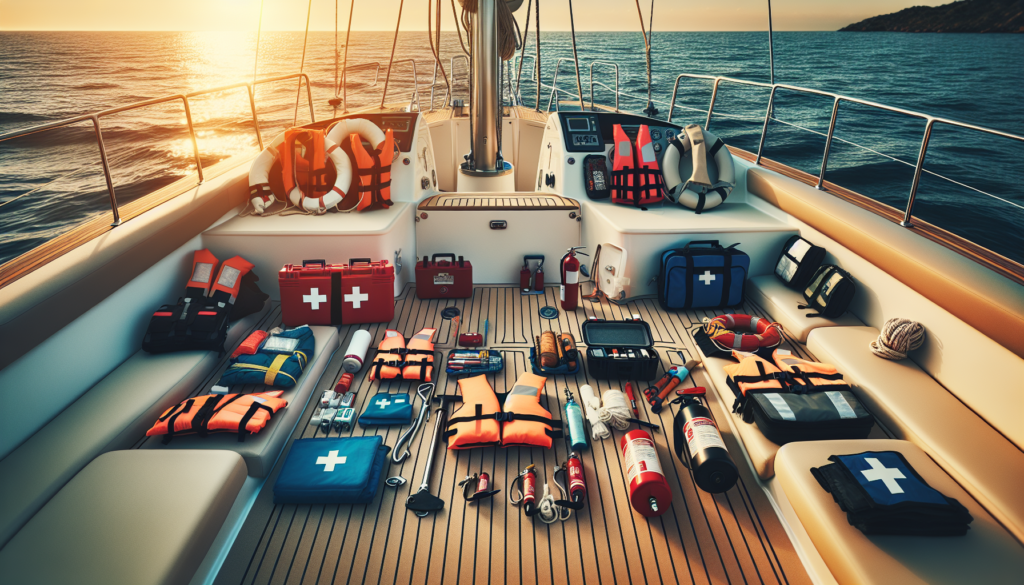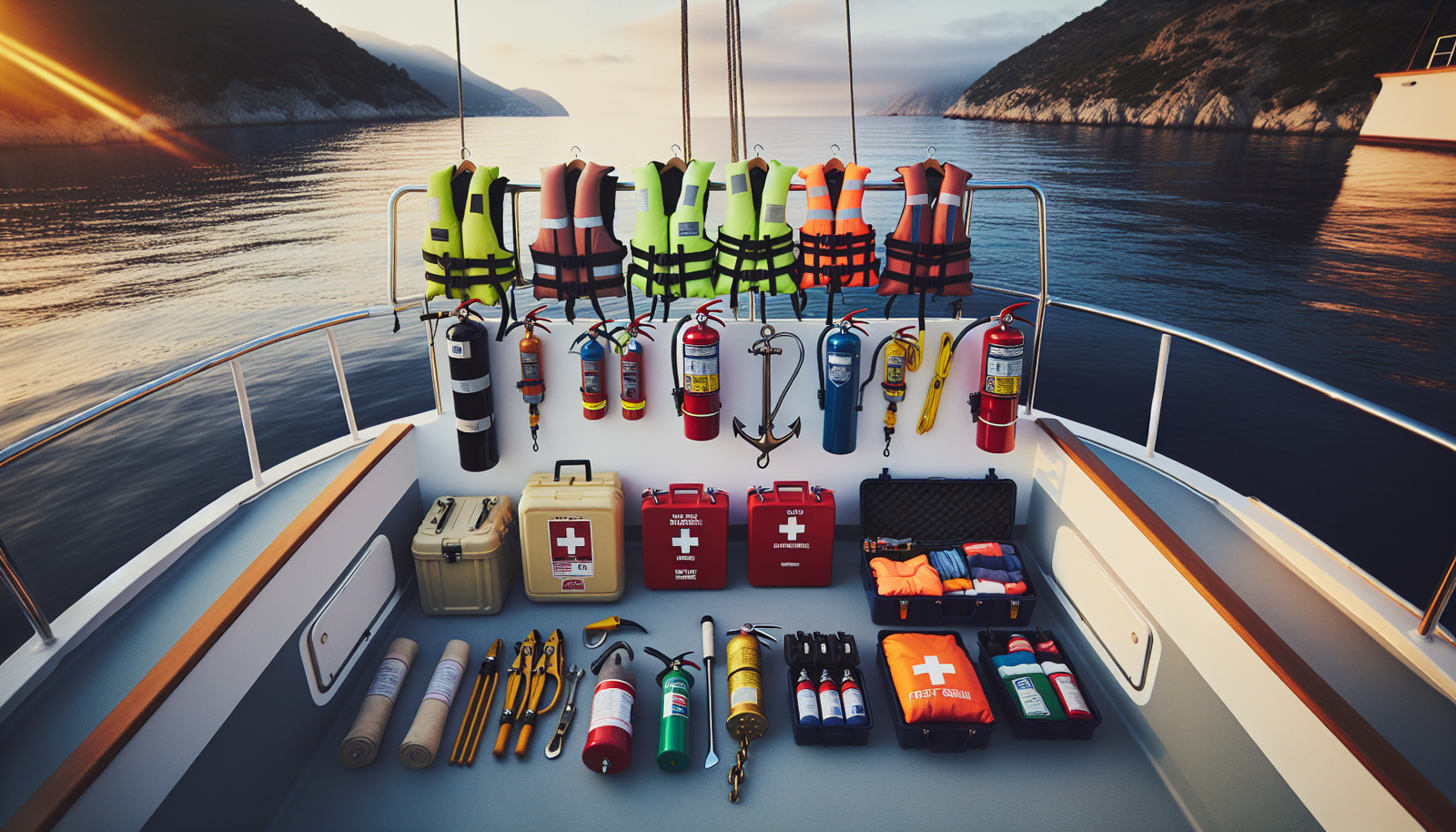Imagine a serene day on the water, where the calming symphony of waves plays the brilliant undertone to your delightful sojourn on the ocean. As the sun glares benignly, the sparkling sea promising endless fun, the rapture of boating takes hold of your senses. But within this picture-perfect narrative of marine adventure, there lurks the reality of uncertainty and danger. To ensure your sailing experience remains spectacular rather than shadowed by mishaps, it’s critical to be prepared with all essential boating safety equipment. Your foresight could make all the difference between an enjoyable outing and a maritime misadventure. Embark on this enriching journey with us as we set sail through the comprehensive “Essential Boating Safety Equipment Checklist.”

Lifejackets and Personal Flotation Devices
You’re on an adventurous trip, enjoying the calming arpeggios of the waves when suddenly, you hit something. Panic ensues, chaos emerges, and in such critical moments, your life may just depend upon the buoyant embrace of a lifejacket or Personal Flotation Device (PFD).
The importance of lifejackets and PFDs
In the gentle lullaby of the waves, Lifejackets and PFDs are the unsung heroes. They are your lifelines, your buoyant safeguards in the uncertain seascape. Without these devices, one careless slip, one unexpected wave, or a sudden storm could very quickly turn a pleasant boating excursion into a life-and-death situation.
Types of lifejackets and PFDs
Just like how every boat is unique, lifejackets and PFDs come in various types, each designed for specific situations and people. Offshore lifejackets, near-shore buoyant vests, flotation aids, throwables, and special use devices – each has its own quirks, requirements, and advantages. Take the time to familiarize yourself with what’s available, the variations, and the respective functionalities.
Maintenance and storage of lifejackets and PFDs
The efficacy of lifejackets and PFDs relies not just on their make and type but also on their condition. Periodic inspection, regular maintenance, and correct storage are crucial. Make sure they’re dry, clean, free of damage, and most importantly, easily accessible in case of emergencies.
Fire Extinguishers
The flame, your partner in warmth and sustenance, could turn into a dangerous adversary within seconds. It’s your responsibility to ensure the fire stays a friend. And this is where boat fire extinguishers step in.
Types of boat fire extinguishers
Boat fires could result from various sources – fuel, electrical malfunctions, flammable materials. There are various types of fire extinguishers available to tackle such varying sources. Class A, B, C, D, and K – each specially designed to combat different kinds of fires.
How to use a boat fire extinguisher
Using a fire extinguisher involves more than simply pointing and spraying. Remember the acronym PASS – Pull, Aim, Squeeze, and Sweep. Pull the pin, aim low at the fire’s base, squeeze the lever, and sweep side to side. In such a daunting frenzy, these steps may just be your saving grace.
Placement and maintenance of fire extinguishers on a boat
Fire extinguishers should be easily accessible, away from potential fire sources, yet not too exposed to environmental elements. Regular inspections are integral. Check for damage, pressure levels, and expiration dates to ensure their usability in a crisis.
Flares and Distress Signals
In the vast expanse of the sea, help could be miles away. Reaching out becomes challenging. Thankfully, we have flares and distress signals to conquer this distance.
Different types of flares and distress signals
From bright red handheld flares, smoke signals, and parachute flares to electronic distress signals – there are numerous ways to signal for help. Understanding the different types and their uses is crucial for anyone setting out to sea.
How to use flares and distress signals
Each flare and distress signal has its usage instructions. Following these are extremely important – misfire can lead to accidents and may also fail to send the distress message. Practice in a controlled environment to get the hang of it.
Storage and expiration of flares and distress signals
These signaling devices should be stored in a dry, cool and easily accessible place. Furthermore, they come with expiration dates and should be replaced once they’ve expired to guarantee their performance in emergencies.

First Aid Kit
A first aid kit is a universal symbol of preparedness, offering essential medical aid in sprains, cuts, bruises, and other minor injuries that can occur on a boat.
Essential items in a boat first aid kit
An efficient first aid kit should be well-stocked with a variety of band-aids, bandages, antiseptic wipes, tweezers, medical tape, painkillers, scissors, and a first aid manual. Depending upon personal needs and boating activities, additional items like seasickness pills, sunscreens, or specific medicines should also be included.
Storing and maintaining your first aid kit
The first aid kit should be stored in an easily accessible, dry place, protected from exposure to water or direct sunlight. The kit must be checked regularly to replace any expired or used items and to ensure everything remains in good condition.
Using a first aid kit in emergency situations
During an emergency, the first aid kit becomes a mini medical facility. Familiarize yourself with its contents, and know how to use each item. In times of crisis, your knowledge of first aid procedures can make all the difference.
VHF Radio and Communication Devices
In the unfathomable depth and expanse of the sea, maintaining communication becomes a challenging yet crucial task.
Importance of a VHF radio on a boat
Boating is an adventurous endeavor that will sometimes take you far from the shores. During such times, VHF Radios become a vital lifeline, connecting you to the shore, other boats, and rescue services.
Using a VHF radio
Understanding the operations of a VHF radio is not as complicated as one might think. With the right operating frequency and common marine terminologies, you can communicate effectively. However, remember, this device is strictly for emergency and navigational communication.
Other communication devices for boating
In addition to VHF radios, there are also other communication devices like EPIRBs, Personal Locator Beacons (PLBs), Cellular Phones, Satellite Phones that aid in keeping you connected while at sea.
Emergency Position Indicating Radio Beacon (EPIRB)
In the labyrinth of the waves, the EPIRB plays the role of the guiding light, connecting you to the potential rescuers.
What is an EPIRB?
EPIRB is a compact, life-saving device that, when activated, transmits distress signals to SAR satellite systems, ultimately notifying rescue services of your location and situation. In the vast sea, this little piece of technology is your homing beacon for rescue.
How to use an EPIRB
Operating an EPIRB is easy. In case of an emergency, switch it on and secure it outside the boat where it has an unobstructed view of the sky, and simply let it do its job – signaling to rescue services about your plight.
Maintenance and testing of the EPIRB
The life-saving magic of an EPIRB relies heavily on its operational ability, which means regular testing and servicing must be done. Its battery must be replaced according to the manufacturer’s guidelines to guarantee its functionality.
Man Overboard Device
The phrase “Man Overboard” can send a chill down any sailor’s spine. But with the right devices in hand, these nightmare scenarios can be tackled efficiently.
What is a Man Overboard device?
A Man Overboard device is a specialized gadget that gets activated when a person falls into the water. It sends out an alert and helps you locate and track the person in water, increasing the chances of a successful rescue.
How to use a Man Overboard device
Most of these devices are automatically activated upon immersion in water. However, learning how to manually activate it, understanding its alerts, and the retrieval process will ensure you’re ready when disaster strikes.
Placement of the Man Overboard device on your boat
Placement is critical. They should be attached to the lifejackets or PFDs of every person on board, ensuring immediate activation if anyone falls overboard.
Boating Tool Kit and Spare Parts
A boat, like any other machine, can have a few hiccups. When surrounded by water miles away from the shore, having handy tools and spare parts could be your timely savior.
Essential tools and spare parts for boating
Your boating toolkit should be well-equipped with screwdrivers, wrenches, hammer, pliers, duct tape, nuts, bolts, spare bulbs, and extra fuel. Also, don’t forget spare parts like fuses, spark plugs, belts, or any other specific part your boat might require.
Using your boating tool kit
Each tool has a specific use and knowing who does what is paramount. Familiarize yourself with the boat’s machinery and understand the role of each tool. Well, after all, a toolbox is only as useful as the person wielding it.
Storing and maintaining your boat’s tool kit and spare parts
Your boat’s toolkit and spare parts should be stored in a dry, accessible place, preferably in a rust-proof box. Regular checks should be carried out for damage or rust, and if need be, replace the tool or part immediately.
Navigation Lights and Sound Signals
Navigating the enchanting darkness of the seascape is made safer with navigation lights and sound signals.
Understanding boat navigation lights
Boat navigation lights, besides illuminating your course, also communicate your boat’s size, direction, and activity to other vessels, preventing potential accidents. Understanding the language of these lights is a valuable skill every boater should acquire.
Using sound signals
Alongside lights, sound signals serve as the echolocation mechanism for boats. Specific sounds broadcast your intentions to others nearby, providing vital safety functionalities in restricted visibility.
Maintenance of navigation lights and sound signals
Regular checks for functionality, correct color, visibility, and alignment are essential for navigation lights. Similarly, the signaling equipment should be tested often for its loudness and correct sound production.
Safety Harnesses and Lines
A armor against the powerful whims of nature, safety harnesses and lines are an indispensable part of your safety gear.
Importance of safety harnesses and lines
Safety harnesses and lines can prevent a joyous adventure on the sea from turning into a disaster. They keep you tethered to the boat, reducing the risks of being thrown overboard during rough seas or bad weather.
Proper use of safety harnesses and lines
Wearing the safety harness firmly, securing the tether lines properly, and ensuring the lines do not obstruct movements or pose a tripping hazard forms the essence of its proper use. Knowledge of quick-release mechanisms in case of emergencies is also paramount.
Maintenance and storage of safety harnesses and lines
Since the functionality of safety harnesses and lines is critical for your safety, regular checks for wear & tear, rust or corrosion on metal parts, and proper functioning of buckles and clasps are essential. They should also be stored in a dry, cool place when not in use.

